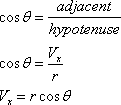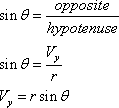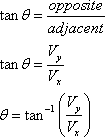Vectors
Vectors are an extremely important tool in physics and engineering. Although the terminology may be new, the mathematics of vectors is the same as the trigonometry and right-triangle geometry that we have been doing.
A physical quantity is expressed as a vector if it has a direction associated with it as well as a magnitude. A good example is force. Certainly the magnitude, or numerical value, is important, but so is the direction in which the force is applied.
Imagine two forces being applied to an object. Perhaps you have two people helping to push a heavy box across the floor. Suppose each person can push with a force of 100 pounds. If they both push in the same direction, the net force will be 200 lbs. in that direction.

This figure also shows how we represent vectors graphically. A vector is shown as an arrow pointing in the correct direction. The length of the arrow shows the magnitude of the vector. Notice that the arrow for the 200 lb. force is twice as long as the arrows for the 100 lb. forces.
Now suppose your two helpers push in opposite directions. Obviously the net force will be zero.

What if they pushed in perpendicular directions? The net force would be at a 45° angle, and would have a value of 141 lbs.

So clearly the directions matter. When you are talking about vectors, you cannot simply say that two 100-lb. forces will add up to a 200-lb. force. It depends on their directions, and we will need a different way to add vectors together that takes this into consideration. But first, let’s talk about describing an individual vector.
To describe a vector we need to specify its magnitude (the length of the arrow) as well as its direction. For a given vector V, we can give its magnitude as a number r, and the direction as an angle θ measured in standard position on an x–y coordinate system. This is called the polar representation of a vector:

This same vector can also be described by giving the x– and y– components of the endpoint of the arrow. These are called the x– and y-components of the vector, denoted by Vx and Vy. Giving the x- and y– components of a vector is called the rectangular representation.

The relationship between the rectangular and polar representations can be found by right-triangle trigonometry. Notice that vector and its components make a right triangle:

Given (r, θ) Find (Vx, Vy)
Since r is the hypotenuse of the triangle and Vx is the side adjacent to θ, we use the cosine function:

Similarly, since Vy is the side opposite the angle, we use the sine function to find it:

Given (Vx, Vy) Find (r, θ)

Because we know two sides of the triangle, we can use the Pythagorean theorem to find r.

Now what we are given is the sides opposite and adjacent tothe angle. The trig function that uses these is the tangent, so

These results are summarized in the following table.
|
Rectangular to Polar |
|
|
|
Polar to Rectangular |
|
|
Of course, you really don’t need to memorize these formulas as long as you know your trig.
Vector Notation
As discussed above, vectors do not obey the ordinary rules of arithmetic. You cannot always say that 100 lb. + 100 lb. = 200 lb. We need a way to show that we mean a vector quantity so that we don’t try to use ordinary arithmetic with it. The convention in printed material is to use a boldface character when we mean a vector quantity, and an italic character when we are only referring to its magnitude (which is just an ordinary number that does obey the usual rules of arithmetic). For example:
A force vector: F (includes magnitude and direction)
It’s magnitude: F (just an ordinary numerical value)
In handwriting, it is difficult to make boldface characters, so we usually put an arrow over the symbol to indicate that it is a vector:
A force vector:  (includes magnitude and direction)
(includes magnitude and direction)
It’s magnitude: F (just an ordinary numerical value)




